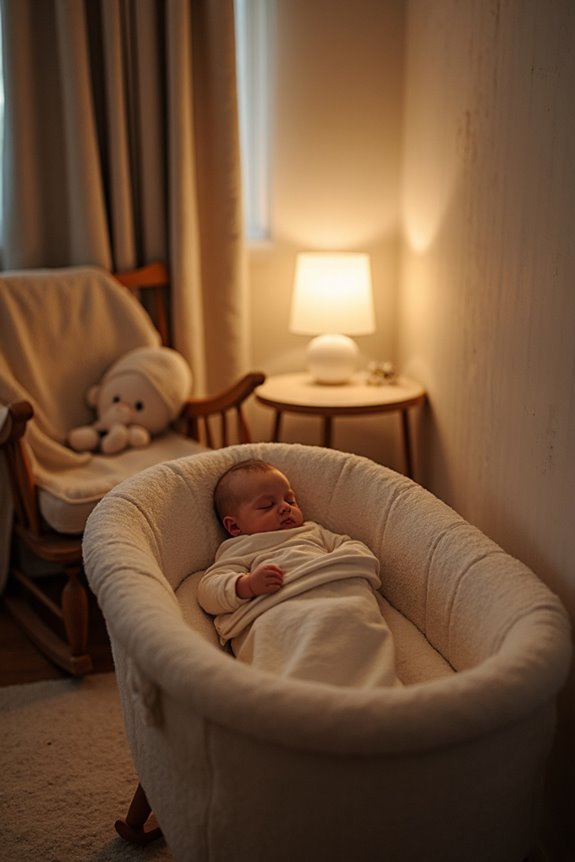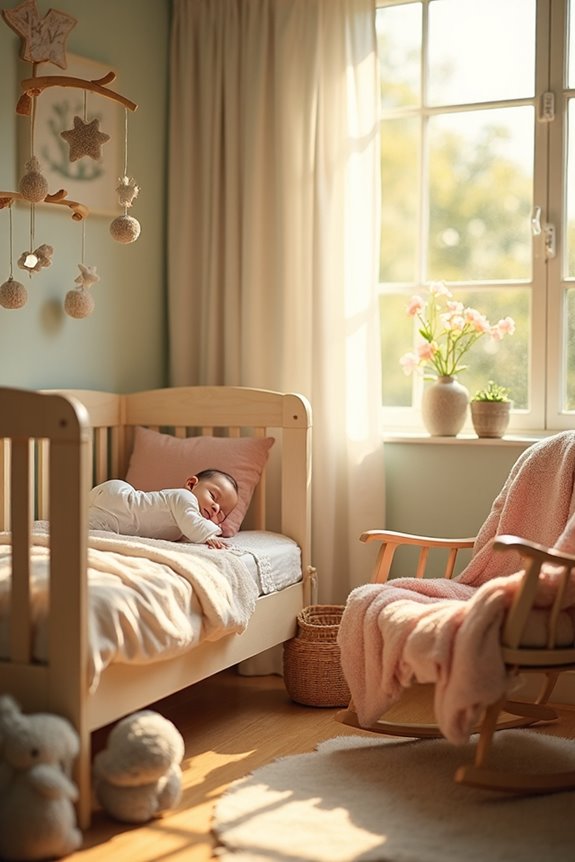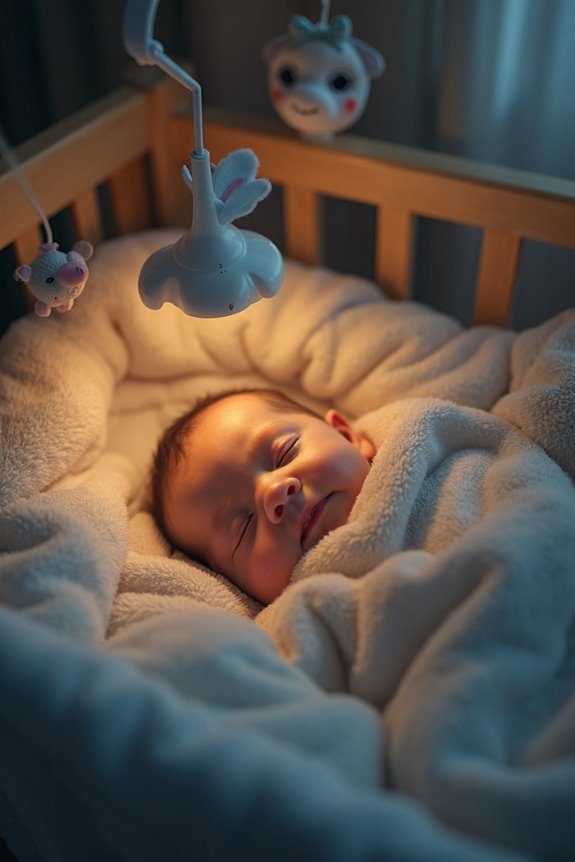We can help your baby sleep comfortably in a bassinet by focusing on key aspects. First, ensure stability with a sturdy base and non-slip feet. Maintain a room temperature between 64-71°F, and use a firm, snug mattress. Keep the bassinet bare—avoid soft bedding and toys. Position your baby on their back, monitor noise and lighting, and consider soothing sounds. Opt for a bassinet with mobility features, making nighttime care easier. Discover more ways to enhance this process.
Key Takeaways
- Maintain a room temperature between 64-71°F to ensure the baby’s comfort and safety.
- Choose a firm mattress with a snug fit to prevent gaps and enhance safety.
- Use a bare bassinet, avoiding pillows and soft bedding to minimize suffocation risks.
- Ensure the bassinet is stable with a wide base and non-slip feet.
- Regularly check baby’s temperature by feeling their chest or neck for signs of overheating.
Ensure a Stable and Secure Bassinet
Ensuring your baby’s bassinet is stable and secure is paramount for their safety and your peace of mind. We should focus on bassinet materials and safety inspections to keep our little ones safe.
- Solid Construction: Choose a bassinet with a sturdy, wide base. Non-slip feet add extra stability, preventing sliding.
- Weight Capacity: Always check the bassinet’s weight capacity, ensuring it’s appropriate for your baby’s size.
- Regular Safety Inspections: Inspect the bassinet regularly for wear or damage, ensuring it remains stable.
Positioning is crucial. Place the bassinet on a flat, even surface. Avoid soft or sloping areas to prevent tipping. Keep it away from hazards like curtain cords. These measures help us create a secure sleeping space for our baby.
Maintain Proper Room Temperature
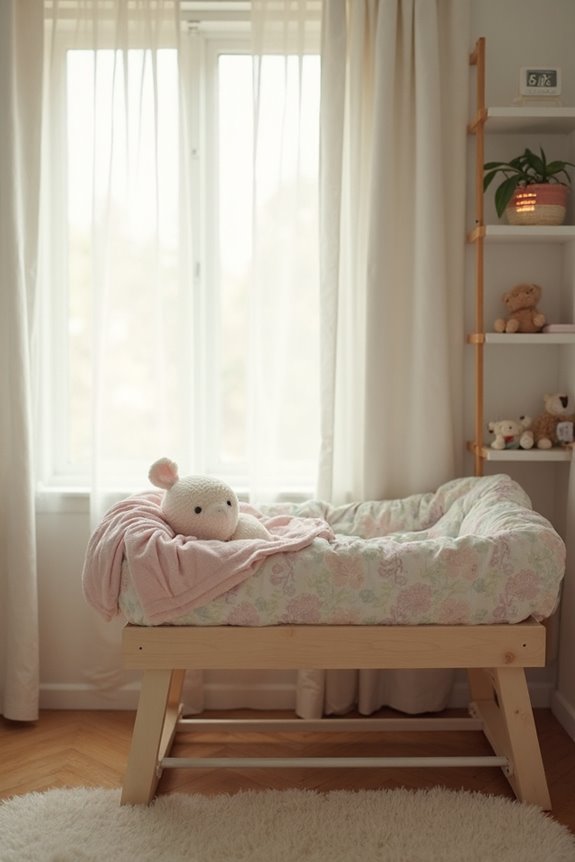
When it comes to maintaining the proper room temperature for your baby, it’s crucial to strike the right balance between comfort and safety. We should aim for 64-71°F (18-21°C) to ensure a cozy environment. Babies can’t regulate their temperature well, so consistent temperature monitoring is key. Using a digital room thermometer helps keep tabs on this.
Let’s remember, seasonal adjustments might be necessary. During colder months, ensure there aren’t any cold spots near the bassinet, and in warmer seasons, avoid overheating by using light bedding. Regularly check your baby’s chest or neck for signs of overheating. By making these thoughtful adjustments, we can create an environment that’s just right, ensuring our little ones sleep peacefully and safely.
Use a Firm and Snug-Fitting Mattress
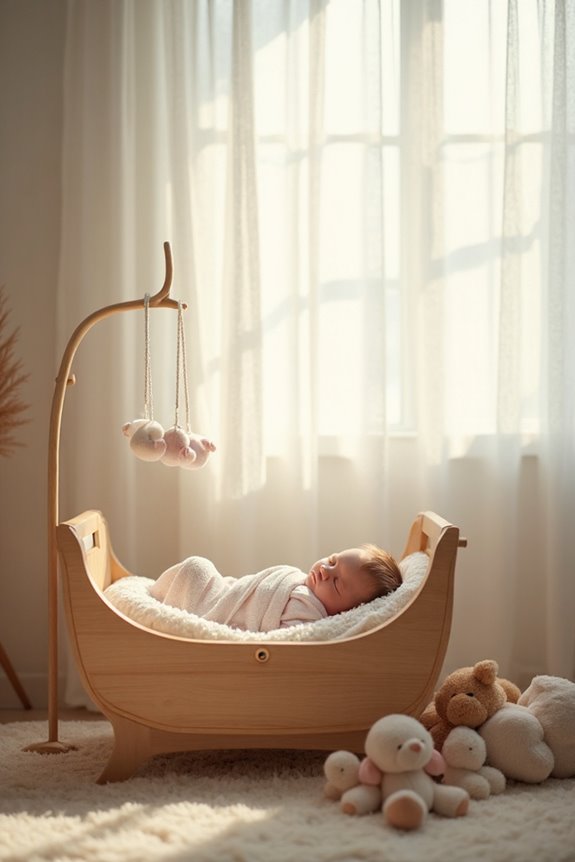
Using a firm and snug-fitting mattress in your baby’s bassinet is essential for creating a safe sleep environment. We can’t stress enough the importance of mattress firmness; it should be between an eight and ten on the firmness scale. This helps prevent the mattress from conforming to your baby’s head, reducing the risk of SIDS. A snug fit ensures there are no gaps between the mattress and bassinet sides, which could pose suffocation hazards. Remember, standard bassinet measurements are typically 33’’x 18’’, but always check the manufacturer’s instructions to ensure the right size. The mattress thickness should ideally be between 1-1.5 inches. By following these guidelines, we help keep our little ones safe and comfortable as they rest.
Keep the Bassinet Bare and Free of Hazards
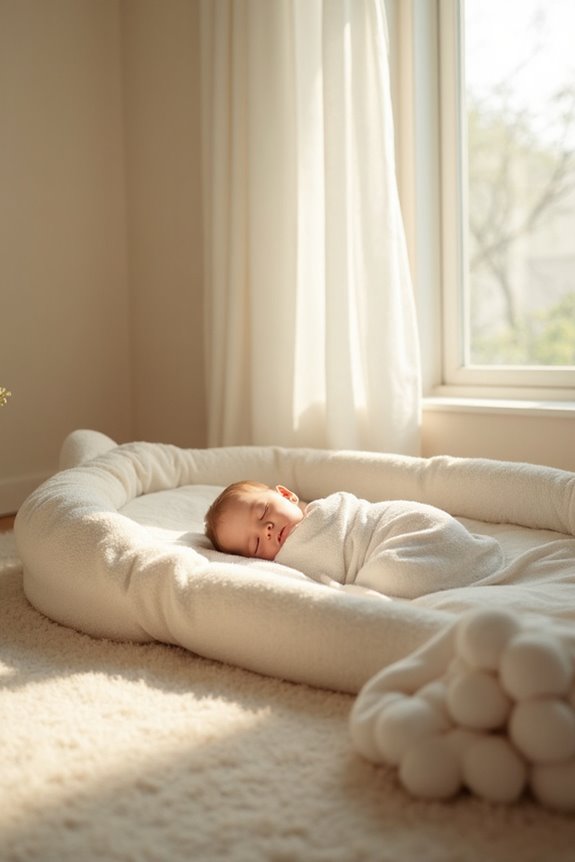
After ensuring a firm and snug-fitting mattress for your baby’s bassinet, we should focus on keeping the bassinet bare and free of hazards to create a safe sleep space. A bare bassinet minimizes risks like suffocation and SUDI. Let’s prioritize hazard awareness by avoiding soft bedding, pillows, and loose clothing. These can increase entrapment risks. Safety accessories like mesh sides promote airflow, reducing suffocation chances. Remember, a toy-free bassinet helps prevent strangulation risks. Regularly check for loose parts or wear that may affect stability. Ensure any accessories, like canopies, are securely attached and meet CPSC guidelines. By following these steps, we create a secure environment, offering peace of mind for both you and your baby.
Position the Baby on Their Back for Sleep
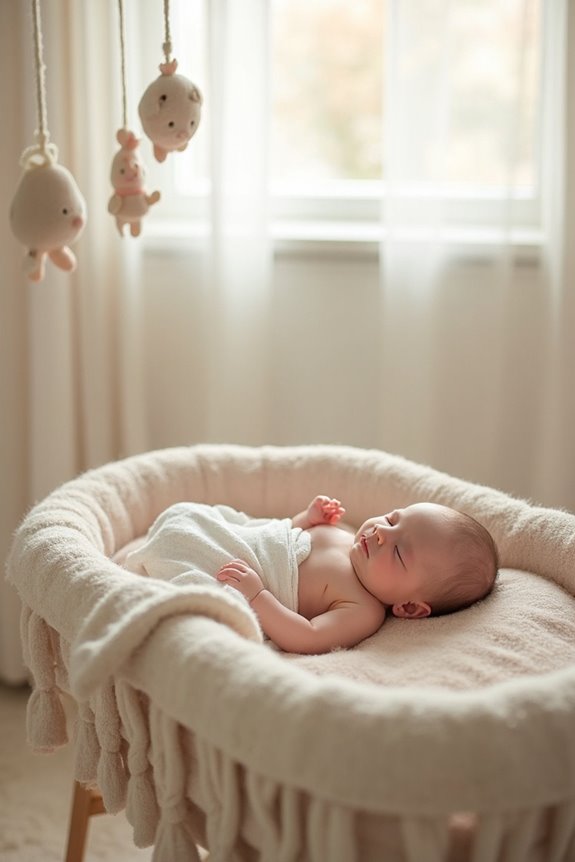
Placing your baby on their back for sleep is a simple yet crucial step in reducing the risk of Sudden Infant Death Syndrome (SIDS). This position, recommended by the American Academy of Pediatrics, forms a foundation for healthy sleep habits. Let’s explore why:
- SIDS Prevention: Back sleeping minimizes the risk compared to stomach or side positions.
- Physiological Benefits: It prevents carbon dioxide buildup, ensuring an adequate oxygen supply.
- Safe for All: Even preterm or reflux babies benefit from this sleep position.
We should maintain this position for at least the first year. It’s not just about safety; it’s about providing peace of mind. By positioning our little ones this way, we’re offering them a secure and nurturing environment.
Choose Breathable and Washable Bedding
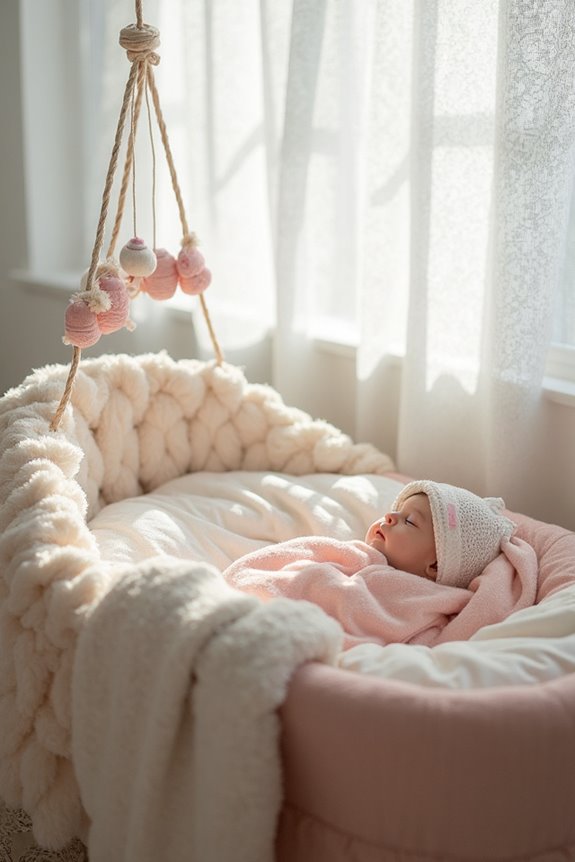
When it comes to ensuring our baby’s comfort and safety during sleep, choosing the right bedding is key. We should opt for breathable materials like cotton or bamboo, which help regulate temperature and reduce the risk of overheating. Organic cotton is a great choice, as it avoids harsh chemicals and reduces skin irritation. Natural fibers and hypoallergenic options are also recommended to keep our little one comfortable and safe.
Washable options are crucial for easy maintenance and hygiene. Bedding that can be tossed in the washing machine saves us time and effort, maintaining a clean environment for our baby. Regular washing helps prevent bacterial growth and reduces allergens, contributing to our peace of mind. Let’s ensure a snug fit to avoid any safety concerns.
Follow Safety Standards and Guidelines
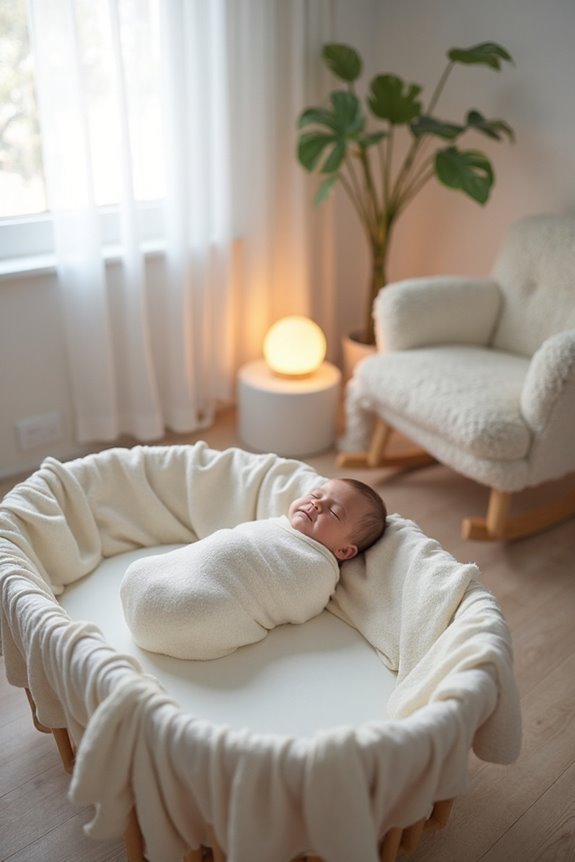
As we consider our baby’s bedding, it’s equally important to ensure their sleep environment adheres to safety standards and guidelines. Let’s delve into the key areas of concern:
- Lead in Paint: We need to verify that our bassinet doesn’t contain lead-based paint, as it’s a significant health risk.
- Structural Integrity: Compliance checks should confirm the bassinet’s structural soundness, following ASTM standards.
- Stability Tests: Regularly conduct stability tests to ensure it won’t tip over easily.
- Mesh and Fabric Openings: Ensure openings meet safety regulations to avoid suffocation hazards.
- Accessories: Avoid loose items and ensure toys and attachments comply with safety standards.
Monitor Noise and Lighting Levels
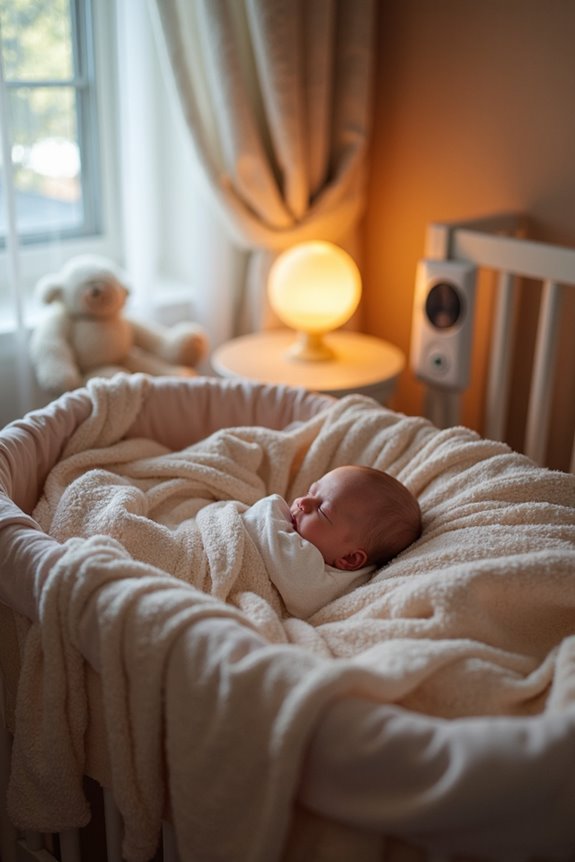
Creating an optimal sleep environment for our baby involves more than just a cozy bassinet; it requires careful monitoring of both noise and lighting levels. We all know that white noise can be soothing, but let’s ensure it’s safe. Keep white noise machines at a distance and limit the volume to under 85 decibels, following AAP guidelines to prevent hearing issues. Studies show prolonged exposure can be harmful, so moderation is key.
When it comes to lighting, dim or soft lighting is ideal. It helps babies distinguish between day and night, promoting better sleep. Low ambient light reduces visual stimulation, making it easier for our little ones to drift off. Avoid bright lights that may disrupt their sleep-wake cycle, creating a peaceful nighttime routine.
Utilize Soothing Sounds for Calming Effects
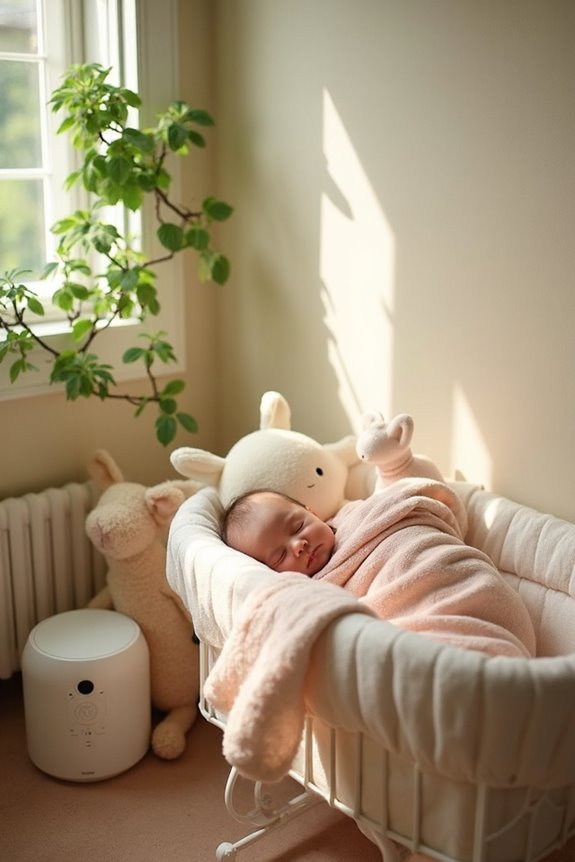
Although getting your baby to sleep can sometimes feel like an insurmountable challenge, utilizing soothing sounds can be a game-changer. Let’s explore how these calming rhythms transform bedtime into a peaceful ritual.
- White Noise: Blocks distracting household sounds, helping your little one drift off faster.
- Pink Noise: Lower-pitched and more natural, it can be even more soothing for some babies.
- Lullabies: Universally calming, these soothing melodies can relax your baby, regardless of language.
Research highlights how these sounds mimic the womb environment, offering familiarity and comfort. Soft music can lower a baby’s heart rate, promoting relaxation. Utilize apps or devices to find what resonates with your child. Remember, consistency is key—play these sounds regularly to establish a comforting bedtime routine.
Opt for Bassinet Mobility and Design Features
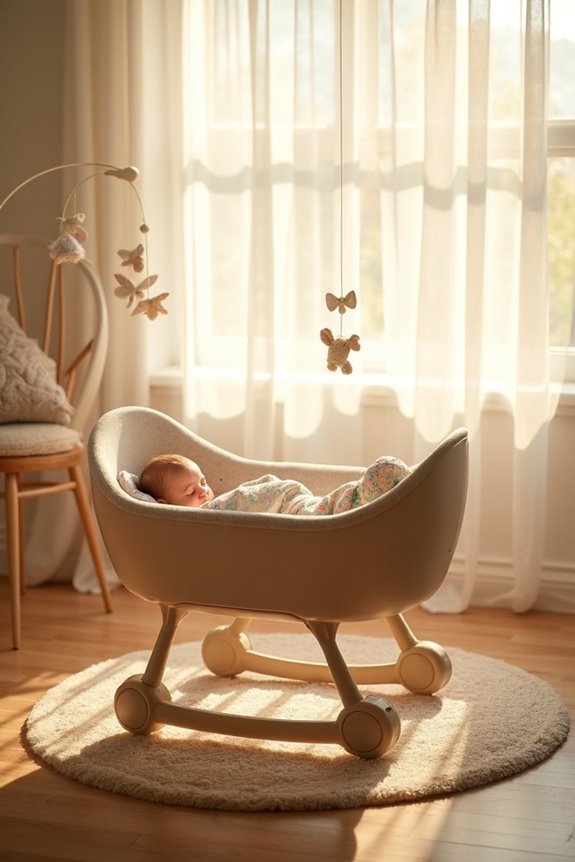
When it comes to crafting a peaceful bedtime routine, selecting the right bassinet can make all the difference. Bassinets mobility and design features are crucial for ensuring our little ones sleep soundly.
- Enhance Portability: Lightweight designs, often with wheels or handles, allow for easy movement throughout the house, making caregiving simpler. Room-to-room versatility keeps your baby close, providing comfort and convenience.
- Travel-Friendly: Folding options offer a familiar sleep environment on the go.
- Breathable Mesh: This design reduces SIDS risk, enhancing airflow and safety.
- Adjustable Height: Customizable leg extensions offer versatility, ensuring the bassinet fits comfortably beside any bed, facilitating nighttime care and bonding.
These thoughtful features ensure both safety and comfort, making the bassinet an invaluable part of your nursery.
Frequently Asked Questions
How Can I Transition My Baby From a Bassinet to a Crib?
We can start the crib transition by adjusting the sleep environment. Let’s keep it consistent and familiar, ensuring a smooth move. Naptime in the crib helps, as does removing swaddles if they’re rolling. Remember, patience’s key.
What Are Signs That My Baby Is Too Big for the Bassinet?
Did you know 60% of babies outgrow bassinets by 5 months? Let’s watch for growth milestones and check the bassinet’s weight limit to ensure our little one’s comfort and safety as they grow rapidly.
How Do I Handle My Baby’s Sleep Regression in a Bassinet?
Let’s tackle our baby’s sleep regression together. By understanding their changing sleep patterns and using soothing techniques like gentle rocking or a calming lullaby, we can help them adjust and find comfort in their bassinet again.
What Can I Do if My Baby Refuses to Sleep in the Bassinet?
Did you know 70% of parents face sleep training challenges? Let’s ensure our little one feels secure by using soothing techniques like swaddling and white noise. Consistency and patience will help them settle into their bassinet comfortably.
How Can I Ensure My Baby Stays Warm Without a Blanket?
We can ensure our baby stays warm without a blanket by using sleep sacks, which provide warmth and safety. Let’s focus on temperature regulation, maintaining the room between 68-72°F, and dressing them in breathable, thin layers.

